Note that the products discussed on our site are independently selected by our editors. Your purchases through our recommendations may earn us a commission at no extra cost to you.
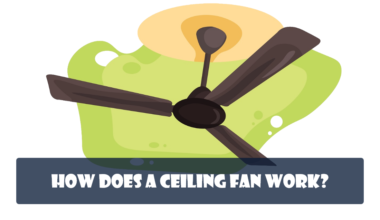
A ceiling fan is a must-have for any modern home. It brings the most needed comfortable breeze on a scorching hot sunny day while also being very cost-effective.
As good as ceiling fans may be, a lot of us don’t really know behind the scenes of how a ceiling fan works. What allows them to make us feel cool though there is no air conditioning? Do they cool the temperature at all? A lot can be asked.
If you too don’t much about ceiling fans and are eager to know, this article is for you. Because in this article, we dive into the mechanics of a ceiling fan and tell you exactly how it works. And we will also discuss some related topics as well.
Sounds good?
Here you go.
What is a ceiling fan?
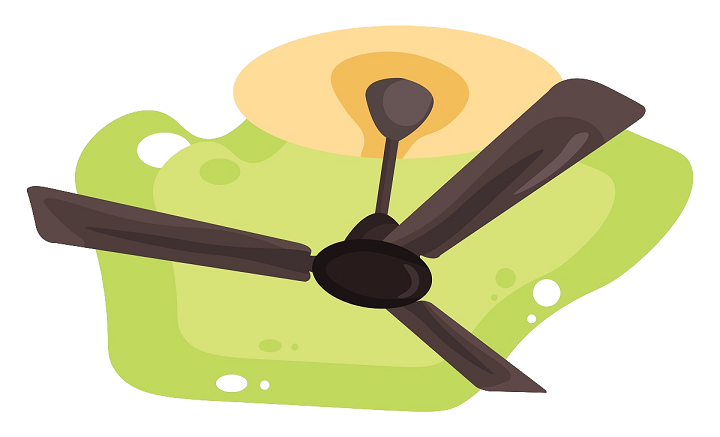
Though we all know what a ceiling fan is, since we are talking about the basics of a ceiling fan, it’s good that we first define what a ceiling fan is.
According to Wikipedia, “A ceiling fan is a fan mounted on the ceiling of a room or space, usually electrically powered, that uses hub-mounted rotating blades to circulate air. They cool people effectively by increasing airspeed.”
So, a ceiling fan really is any fan that is mounted on the ceiling for the purpose of circulating the air to “make us feel cooler”. Pay attention to the double quotes. They are important. We will explain later.
Ceiling fan parts
A ceiling fan consists of many different parts, each of which has a particular role to play. We will discuss each of them briefly below.
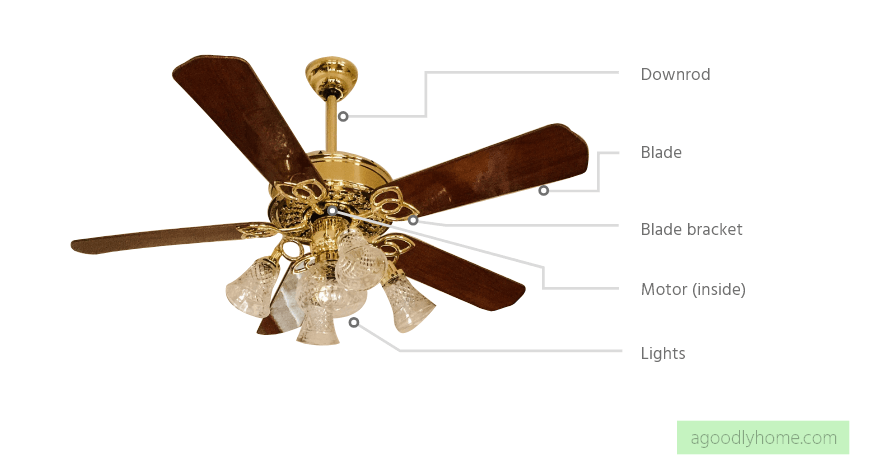
Hanger ball
This is perhaps the topmost part of a ceiling fan. However, it’s usually invisible to the average eye from the floor. That is because it sits right inside the upper canopy. It’s a plastic half-ball type structure that attaches to the downrod and makes the ceiling fan firmly attach to the ceiling.
Canopies
The canopies are the dome-like objects that sit at the ends of the downrod. They don’t have any practical role to play other than to hide the wires. So, their role is not functional but aesthetic.
Downrod
This is a metal tube that connects the fan to the ceiling. The fan can directly connect to the ceiling, but in places where the ceiling is high, the downrod is used to make the overall shape of the ceiling fan taller by increasing the gap between the fan and the ceiling. Downrods come in different sizes depending on the need of the consumer. In places where the ceiling is high, the downrod is a vital part of the whole fan. It also helps increase the efficiency of the fan.
Motor
The motor is yet another vital part of a ceiling fan, if not THE most vital one. It is responsible for the rotation of the fan’s blades. So, without the motor, there’s no fan.
Blades
The blades of a ceiling fan are responsible for the circulation of the air. Blades are thin shits of plastic, wood, or metal that sit at an angle called “the pitch”. When the fan rotates, the blades move the air creating the much-needed air circulation.
Lights
Lights are sometimes additionally added to ceiling fans. They are not essential for the functioning of the fan. They increase the ambient brightness of a space. They sometimes even replace other lights. With most fans, they can be operated independently of the fan. Current ceiling fans are widely compatible with LED, Halogen, and Edison light bulbs.
Light Globe
Light globes are the covers for the light bulbs. Sometimes they are separately installed for each bulb, and at other times they cover all the bulbs all at once.
Pull-chains
Pull chains are chains that hang from the ceiling fan. They are self-explanatory. They are like chains on trains. You pull them to control the ceiling fan and the lights. Some modern ceiling fans don’t feature chains, instead, they are operated using wall switches or remote control devices.
Remote
Not all ceiling fans come with remotes. Some modern ceiling fans do. They add the convenience of controlling the fan from a distance without having to physically move switches either on the walls or on the fan itself. Modern ceiling fan remotes controls have sophisticated features such as “Natural Breeze Simulator”, “Turn off delay”, etc.
How a ceiling fan works
Ceiling fans are a wonder of engineering. They rely on the simple phenomenon of the Windchill effect to create the much-needed comfortable breeze on a scorching hot sunny day.
A ceiling fan works by converting electrical energy into mechanical energy to simulate the natural wind. We all know that when the wind blows, we feel cooler, right? Well, that’s exactly what a ceiling fan does. It uses electrical energy to rotate the blades. The blades are fixed at a pitch on the body of the ceiling fan. Due to this fact, when the fan speeds up, the blades create an airflow. Consider this airflow to be the blowing breeze that you find outside naturally. The effect on our bodies is the same in both situations. We “feel” cooler. Contrary to what you might believe, a ceiling fan does not cool the air, rather it circulates it, which makes you feel cooler, just as it does outside on a windy day. That’s how a ceiling fan works.
Types of ceiling fans
There are many different types of ceiling fans. They can be categorized based on a number of factors. The following is a classification of ceiling fans depending on different factors.
Outdoor vs. Indoor ceiling fans

Perhaps the most important classification of ceiling fans is Outdoor vs. Indoor. This is something that you have to keep in mind when buying ceiling fans. Outdoor and indoor ceiling fans may look the same but they are built for different locations with different capabilities. There are three types of ceiling fans in this regard – Dry-rated, Damp-rated, and Wet-rated ceiling fans. Dry-rated ones are meant for indoor areas completely covered and insulated from the elements such as bedrooms, and living rooms. Damp-rated ones are meant for covered outdoor areas such as covered patios and porches, and Wet-rated ones are meant for uncovered outdoor areas such as pergolas and verandas. Outdoor fans can be installed both indoors and outdoors, while indoor fans can only be installed indoors. Find out more about this subject here: Outdoor vs. Indoor ceiling fans.
Flush Mount, Downrod Mount, Angle Mount
Another point based on which we can classify ceiling fans is the mounting options. Ceiling fans are of three types in this regard. Downrod Mount, Flush Mount, and Angle Mount.
Downrod mounts are when you install your ceiling fan with a downrod.
Flush mounts are when you install your ceiling fans without a downrod, completely flushed to the ceiling. This type of mount is applicable in low-ceiling spaces.
Angle mount is self-explanatory. It is when you install your ceiling fan at an angle on a sloped ceiling.
Retractable vs. Non-retractable
Another point based on which we can classify ceiling fans is retractability. Ceiling fans are of two types in this regard. One type is the normal type where they have normal, fixed blades. The other type is those whose blades can be retracted inside to allow the unit to look like a chandelier. And when it’s time for some breeze, the blades can be pulled out, making it again look like a ceiling fan.
With lights vs. Without Lights
Some ceiling fans come with lights on board, some come without. Modern ceiling fans usually feature LED and Edison bulbs.
Other types of ceiling fans
There are some other ceiling fans that are out of the ordinary. This includes fans that don’t have exposed blades. Sometimes these fans are also called box ceiling fans.
Price of ceiling fans
Ceiling fan prices can vary greatly. If you take a look into the ceiling fan market today, you will find ceiling fans ranging from $80 to way above $1000. The price largely depends on the brand, the size, the features, and the materials the fan is made of.
The efficiency of Ceiling Fans
When it comes to HVAC, you really have pretty much two options only – ACs and fans. Both have the job of cooling down people. And both do their job perfectly fine. You could think of them as siblings in that regard.
However, when you take a look at the electricity consumption of both, you will instantly see the difference! Ceiling fans win the game by a large margin over there. Though I wouldn’t compare a ceiling fan to an AC, still you really have almost the same comfort at a fraction of the cost with ceiling fans.
That is because an average AC unit would consume about 1000 to 2500 watts of electricity to operate. Whereas a ceiling fan only needs about 20 watts of power to operate. Do the math, and you will instantly see that a ceiling fan only needs one-fiftieth of the power that an AC unit needs.
And if you use a ceiling fan with an AC unit, you can cut down on energy usage even more. Find out more about it here.
Aesthetic Value of Ceiling Fans

Ceiling fans are not only functional, but rather they also provide a lot of aesthetic value. Long gone are the days when a ceiling fan was only meant to bring a comfortable breeze on a sunny day. Today, ceiling fans are both functional and aesthetically appealing. Today’s modern ceiling fans can instantly spruce up any interior setting. In fact, nowadays it’s almost impossible to think of an interior space without a ceiling fan installed in it, be it a bedroom, living room, bathroom, kitchen, laundry room, or even a hallway. And talk about a porch or patio, the decoration would really be incomplete without a ceiling fan. So, today’s ceiling fans are not functional pieces of appliances only, they are statement pieces too! Find out more about this subject here: are ceiling fans outdated, and here: ceiling fan pros and cons.
Good Ceiling Fan Brands

There’s a plethora of ceiling fan brands on the market today, each coming up with its “best” ceiling fan. However, not all of them are reliable.
We have previously done a round-up of the best ceiling fan brands. Check it out here: best ceiling fan brands.
If you are still asking for names, we suggest that you buy your fan from brands such as Hunter, Minka-Aire, Craftmade, Modern Forms, Honeywell, Kichler, and Prominence Home.
How to Choose a Ceiling Fan
At this point, you might ask, okay, it’s fine, but how do I select my next ceiling fan? What are the things to keep in mind?
To answer that, we say, you need to keep a number of things in mind when buying your ceiling fan.
You need to understand what type of ceiling fan you need. Outdoor fan or indoor fan. Angle mount fan, flush mount, or normal mount? What size?
We have answered all of that previously here: how to buy ceiling fans.
Misconceptions
With that, it’s time to debunk some misconceptions about this masterpiece of engineering. Let’s do that now.
Ceiling fans cool space
A lot of people think that ceiling fans are like ACs and that they cool the space. That is just not true. The truth is the opposite. Ceiling fans don’t cool the space, rather they circulate the air. And when this high-speed air passed over our bodies, it makes us “feel” cooler, just like it does on a windy day outside.
The fact is, ceiling fans don’t lower the actual temperature of the space like an AC unit does. If anything, they actually increase the temperature a bit. This is because of the heat generated by the motor. This increase in temperature is so small that we never notice it.
Ceiling fans use a lot of electricity
If a person does not know much about ceiling fans, it’s natural for him/her to think that ceiling fans consume a lot of electricity. However, a simple reality check would tell you that this is not true at all. Ceiling fans literally run on pennies. An average ceiling fan would consume only about 20 watts on average speed which would translate to less than $15 per year to operate. You can see, they are very cost-effective.
FAQ
Can ceiling fan fall?
When you see a ceiling fan for the first time, it’s natural to wonder whether it will fall. However, ceiling fan falls are extremely rare. And in the rare events when they do fall, that’s only because of improper installation or poor maintenance. Find out more about it here: can ceiling fans fall?
Can ceiling fans kill you?
Death by ceiling fans is also extremely rare. A ceiling fan won’t explode or fall if installed correctly. In the event that you get hit by a ceiling fan, it can be dangerous, but not life-threatening. But if you are talking about babies, yes, it can be fatal for them if they get hit.
What ceiling fan size do I need?
52 inches is the most common ceiling fan size. However, the exact size you need depends on the size of your room. Refer to this article of ours for that: How to measure ceiling fan size.
What ceiling fan moves the most air?
CFM/W is the key when it comes to figuring out which ceiling fan moves the most air. Look for a high CFM/W rating when shopping for your next ceiling fan, and you will have good airflow with your fan.
Final Words
There you have it.
This has been our take on “how a ceiling fan works”. We hope that our guide has been helpful for you to understand the working of a ceiling fan.
Do you have anything that you may want to tell us? Let us know in the comments section below. Thank you for reading.
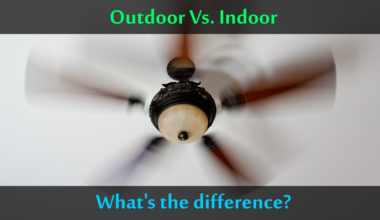



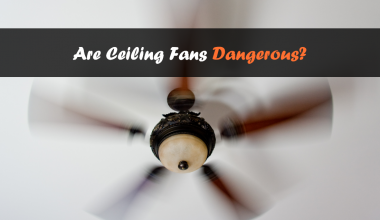


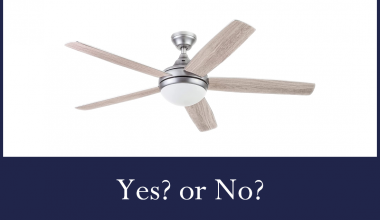
Conversation
No Comments here